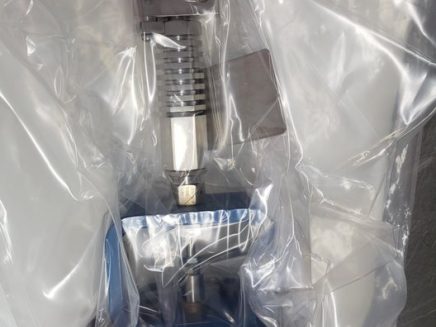What is Oxygen Cleaning?
Oxygen cleaning is a method of cleaning and effectively removing contaminants from equipment intended for use with liquid or gaseous oxygen.
These contaminants are primarily hydrocarbon-based and include scale, oil, grease, and organic or inorganic compounds, which, if left alone, can cause clogging in equipment and potential risks, including fires.
PFC provides oxygen cleaning services to different parts and products that include pipes, tubes, valves, hoses, fittings, and other entirely fabricated components. Plus, oxygen cleaning can be performed on various materials, including stainless steel, aluminum, copper, titanium, teflon, and other plastics, metals and alloys.
Where is it used?
All industries that employ liquid or gaseous oxygen systems need regular oxygen cleaning of equipment, including aerospace, military and defense, manufacturing, food and beverage, pharmaceutical, biotechnology, and the compressed gas industry.
All of these industries require sterile and contamination-free equipment as a basic necessity for their regular operations.
Why is Oxygen Cleaning Required?
The risk of a fire always looms large wherever oxygen is present in high concentration. While oxygen itself can't be flamed, its presence is the primary requirement to light a fire.
Hence, it can cause simple materials like oil residue, carbon particulates, or lint to catch fire or explode. But, "how can a fire start in such equipment?"
In high oxygen environments, the potential heat source can come from several sources like:
- Friction from materials sliding against each other.
- Static electricity or electrical arcs from equipment.
- Impact of one object or particle striking another.
- Constant vibration or resonance.
- The heat dissipated from compression.
Besides the obvious risk of ignition, contamination can cause severe damage to components, diminish product quality, and endanger human lives.
Standards
Governing bodies have set forth some regulations to ensure standardized execution of oxygen cleaning projects. Some of the most notable standards' governing organization are:
- ISO (International Organization for Standardization)
- ASTM (American Society for Testing and Materials)
- CGA (Compressed Gas Association)
- KSC (Kennedy Space Center)
- IEST (Institute of Environmental Services and Technology)
- SAE (Society of Automotive Engineers)
There are a few others too, and all of these have tried to reconcile their recommendations and requirements to make standardized regulations for oxygen cleaning services.
Having a vast range of standards does mean that there is some difference in recommendations and requirements. Still, it also makes sure that cleanliness protocols account for all primary and auxiliary parts of oxygen systems.
Oxygen Cleaning Process
The oxygen cleaning process can be performed on-site or in-shop facilities that feature cleanrooms. However, depending on the nature of contaminants, there are different methods to perform oxygen cleaning.
First, let's study the type of contaminants to look out for. According to ASTM G93, there are three types of contaminants:
- Organic Contaminants
- VOC compounds
- Hydrocarbon-based greases and oils
- Inorganic Contaminants
- Cutting Oil
- Water-based detergents
- Nitrates
- Phosphates
- Mineral Acids
- Particulates
- Particles, lint, and fibers
- Dust
- Welding slag
Methods
Though organizations and clients set forth standards or their requirements, the oxygen cleaning method to be used is determined by the type of contamination.
The following is a list of some common cleaning methods:
- Mechanical cleaning
This method includes sandblasting, grinding, and wire brushing to remove scale, paint, or other coatings and welding slag.
- Aqueous cleaning
Aqueous cleaning is done in two ways depending upon the type of contamination. 1) Hot water or steam is used to remove water-soluble contaminants, and 2) alkaline is sprayed, immersed, or hand-applied to remove hydrocarbon oils, grease, and wax.
- Semi-aqueous cleaning
In the case of heavy grease oils or hardened wax, aqueous cleaning is employed by using a hydrocarbon solvent and water emulsion.
. 4. Acid cleaning
Three different acids are used to remove different kinds of contamination.
- Hydrochloric acid removes rust, scale, but it is suggested only for carbon and minor alloys. Plus, it will strip plating and coatings, including chrome, zinc, and cadmium.
- Chromic acid or nitric acid is mainly used for deoxidizing, brightening, and removing alkaline residues. It is recommended for aluminum, copper, and their alloys and effectively removes oils.
- Phosphoric acid removes oxides, light rust, and fluxes
. 5. Solvent washing
Solvent washing is performed with alcohol or other solvents. It is used to re-clean areas as warranted by inspection.
. 6. Vapor degreasing
Vapor degreasing is used for areas that are not easily accessible. This technique uses a vaporized solvent, and the part to be cleaned is kept at a low temperature.
Why Hire PFC?
Precision Fabricating & Cleaning employs highly qualified and trained personnel and ISO-certified cleanroom facilities to provide high-purity oxygen cleaning service. Moreover, the company's nearly 60 years of experience combined with engineering knowledge, latest technologies, and efficient administrative operations always guarantee satisfactory project completion.
PFC provides oxygen cleaning services to the following specifications:
| 0-73579 | 1P00070 | 1P00071 |
| 24555-GEN-0001 | 24555-SPEC-0003 | 5-75014 |
| 5-75059 | 5-75192 | ARP1176 |
| ARP1176 | ARP598 | ARP599 |
| AS4059 | AS598 | ASTM D1193 |
| ASTM F312 | ASTM F331 | ASTM G93 |
| CGA 4.1 | IEST-STD-CC1246 | ISO 14644 |
| ISO 14952 | C-SPEC-C-20C | JSKSC-C-123 |
| MA0110-301 | MA0110-301 | MAP211025 VC |
| MIL-PRF-27401 | MIL-SPEC-164D | MIL-STD-1246 |
| MIL-STD-1246 | MSFC-SPEC-164 | NAVY OXYGEN CLEANER NOC |
| PWA 80-81 | RA0110-018 | RA0110-046 |
| RA0110-047 | RA0110-24 | RA1110-022 |
| RA1110-025 | RA1610-065 | RA1610-075 |
| RA321270 | RAPWA80 | RAPWASP80 |
| RPTSTD-8070-0001 | SAE ARP 598 | SAE ARP1176 |
| SN-C-0005 | STP0565 | STP0637 |
| STP1012 | RL10012 | D-0656395 |
| MC072214 | B185020 | STP 50408 |
| MP 50063 | AS 611 | ECSS-E-ST-35-06C |

